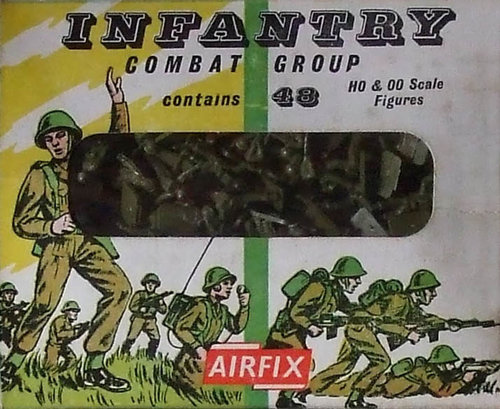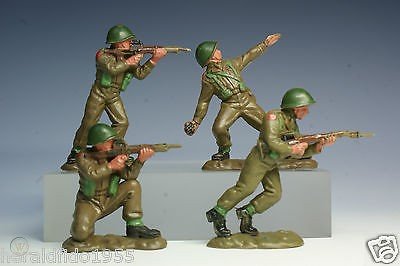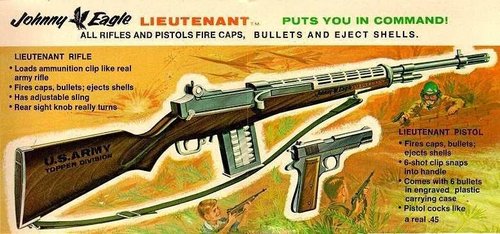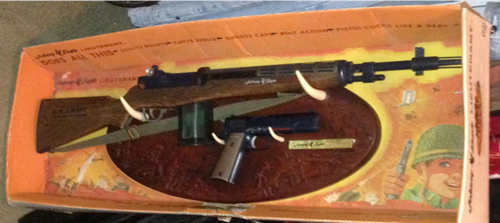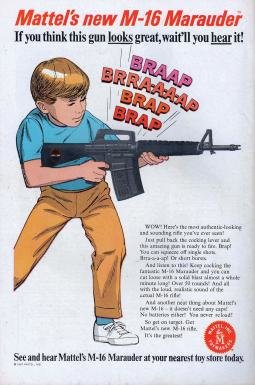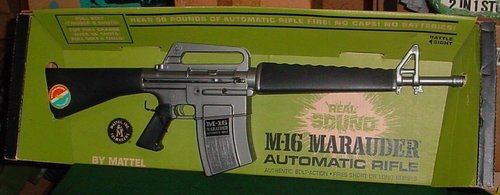Pardon me, this thread just popped up. Working through the old comments.
There is one thing I don't understand:why would the UK submit a ( admittedly redesigned) Belgian design along with a groundbreaking design boasted to be the best thing since toasted bread? Does anybody have information wether this was based on political or technical grounds? Was the reliability of the EM2 ever in doubt? The film in the link I posted would prove the opposite, but that was propaganda.
Mostly because US Army Ordnance Branch threw the world's biggest hissy-fit over the idea of using a bullpup rifle EVER.
I've wondered if there would still have been the move from 7.62mm to 5.56mm if we had adopted the 7mm round.
Although if I recall correctly the SA80 was originally designed with a 4.85mm round. Would this round have replaced the 7mm. How did its performance compare to the 5.56mm?
Maybe. It's possible that the 7mm might have led to a shorter/smaller case as powders got even better. After all, today you can get 6.8SPC2 or 6.5 Grendel that have roughly similar performance with shorter/smaller cases.
The 4.85 was intended to punch the light titanium Spetsnaz armor and helmets. When the Belgians rolled out their steel cored SS109 ammunition it pretty much wiped out the 4.85mm's chances. You needed new barrels for the M855 62gr ammo, but barrels are a wear item anyways.
If the US had agreed to the .280 (7mm) then there never would have been a 7.62x51mm and subsequently a 5.56x45mm M193. So most likely there never would have been another 1970s cartridge competition for which the SS109 5.56x45mm and the 4.85mm (really a 5mm) round were developed. We would all be happily using 7mm to this day.
Not sure I agree with that.
The 5.56 and AR15 was adopted by the US because the USAF wanted something to replace their worn-out M2 Carbines for their base security troops. As a side note, it was also very lightweight so easy to carry all day and was wanted by the US Army trainers etc working in Vietnam.
Make me a 6.5-7lb rifle in .280 and it might work out that the AR never gets adopted by the US Army. But the FAL was at least 8.5lbs in .280, so the "easy to carry" argument still has legs.
What would have been interesting is what rounds would have been developed to replace the .303 and .30 (7.62x57mm) for use by snipers who would have wanted a flatter trajectory. This could have resulted in the bigger .300 and .338 being fielded in armies decades before they were.
Not so much "flatter" as "longer ranged"
The .280's flight path would stay within 6'/1.8m of the ground out to about 600m/y. Which is perfectly acceptable for the basic rifle and arguably any light machine guns. We can argue if 600m is good enough for a "General Purpose Machine Gun" like the FN MAG or MG42.
I suspect that the .300winchester magnum would be the early adopted caliber, if not .338winmag. Both are acceptable for snipers, but not for anything belt fed. Both .300 and .338 winmags have a belted case like the .375H&H, which does not play well with belt feeds. At least not push-through belt feeds.
The definition of "Assault rifle" did not originally include any reference to the type of cartridge utilised. It only referred to the matter of selective fire and ammunition source.
The US Army definition includes "intermediate caliber."
Something with more oomph than even the scary hot 9mm and 7.62x25 SMG-only ammo, but not as much oomph as rifle or machine gun ammunition.
And if you want to really get into it, the 6.5 Arisaka throws a 9gram pointed bullet at 770m/s,
2600J. The 7x57mm Mauser is somewhat comparable in energy with the original round-nosed bullet and is over 3200J with a pointed bullet. 8mm Mauser runs about 4000J for a pointed bullet, .303 British runs about 3400J for the pointed bullet, 7.62x54R runs about 3600J, and the big ugly .30-06 M2 Ball runs about 3600J.
The 7.62x39 runs about 2200 Joules.
So the Fedorov Avtomat is much closer to an assault rifle firing intermediate ammo than it is to a full power rifle.
I am sure I should know this, but why did the UK do such a botched job on the SA80 when it could have drawn on the seemingly much better EM2?
Because Treasury was entirely too cheap to buy the AR18 license, and instead had a bunch of engineers that had never designed a firearm before in their lives reverse engineer the AR18 bits (not the engineers fault at all, they didn't know what they didn't know), followed by having the weapons made at a factory that was going to be closed as soon as SA80 production finished.
And as a rider, is the Bullpup rifle now dead?
Most definitely not!
The Israelis are still buying even more Tavor shorties, and the Croats are buying an AR18/G36 based bullpup (and selling it in the US as the Springfield Hellion)
On the GPMG question, I'd have thought someone would suggest a lick of paint for the BREN, as one alternative.
And keep a few vickers.....
While the UK did keep a lot of Bren guns in service after converting to 7.62NATO (and had a plan for a .280 conversion as well), the way people
use machine guns has changed since the Vickers was designed. People want the guns more mobile, and care a LOT less about the ability to just dump rounds downrange constantly (250rd bursts and changing barrels every 10,000 rounds/40 belts). Just ask the Germans how mobile even an MG08/15 actually is.
The problem was retrofitting lake City and every other ammunition plant to produce a round with a new base diameter. That's where the big costs would have been.
Not that big a deal, not when there are probably 100 other ammunition plants in the US at the time that were already making cases that size
and the tooling wears out over time anyways.
Now, making .280cal bullets might be a bigger bottleneck than cases.
Top it off with the other rounds not actually being anywhere close to production ready or good for that matter.
Spending all that money to tool up for frankly underwhelming cartridges that wouldn't be useful for a bunch of tasks was obviously a nonstarter.
The plain truth is these rounds didn't actually do anything better than 7.62x51(x49 at the time maybe) and weren't going to actually make guns appreciably lighter or better performing.
You're the one being silly.
Full auto 7.62x51 is not controllable from the shoulder in anything lighter than about 18lbs (the M1918 BAR),
and even then it's marginal. ~23lbs/10kg is controllable, but I don't like carrying an M60E3 around.
Full auto .280 British
is controllable from the shoulder
in a 9lb rifle.
In the context of the actual situation at hand, 7.62 nato was actually the right answer at the time.
No, it wasn't. .30-06 was recognized as too powerful. You couldn't easily control even a BAR in full auto. So they looked for something lighter and more controllable. After all, after 2 wars in Europe, it finally sank into people's heads that you didn't need to shoot past about 300m to hit individual troops. You just couldn't really see farther than that!
Then this idiot LtCol by the name of Rene Studler in US Army Ordnance Branch threw a
massive hissy fit
that no cartridge less powerful than .30-06 M2 Ball was acceptable. Hence the 7.62NATO firing a 150gr projectile at 2800fps, exactly the same stats as M2 Ball, just in a shorter overall package.
There's a reason or two that the US Army kept the M14 in service
for less than a decade.
1) It took until 1957 before the government arsenals finally admitted that they didn't have the engineering skills to turn M1 Garands into M14s en masse and built new rifles instead. There goes one of the reasons to stick with .30cal in general.
2) And then we circle back around to the USAF replacing all their now 20yo and completely clapped out M2 carbines with AR15s in 1965. Now the Army advisors in Vietnam discover how much easier the M16 is to lug around than the M14. (The M15 being a heavy barrel M14 that was discarded for M60s really quickly, because it wasn't controllable in full auto despite weighing more than the M14.)
Now OTOH, x51 nato is well past it's prime and could really use replacement asap.
That would be the new 6.8x51mm, aka .277 SIG Fury. Should make a great MG and DMR round, but I doubt it will prove effective as the basic infantry round.
Too. Much. Recoil.
Something about the power level of 6.5 Grendel is about right for infantry. Can load it with a 140gr/9g projectile at 2500fps/770m/s, or a 90gr/6g projectile at 2900fps/880m/s. 2500-2600Joules muzzle energy. Good out to 600-800m from a lightweight rifle (AR platform, ~9lbs all up with 26rd magazine and optic), the SOCOM guys don't see the need for anything bigger as the basic rifle.
And funny enough,
that's right at the power level of the .280 British, just in a much shorter overall package.

